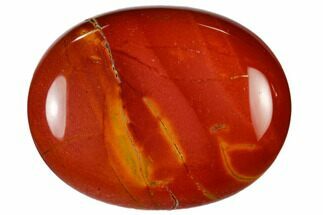1.8" Polished Mookaite Jasper Worry Stones
These are 1.8" wide, polished, mookaite jasper worry stones. The colorations vary significantly from purples, reds, oranges to yellows.
Worry stones are smooth, polished stones, usually in the shape of an oval, with a thumb-sized indentation. They are often used by people for relaxation or anxiety relief purposes, the same way as some people use a fidget spinner. Typically, worry stones are 1 1/2 to 2 inches across. They may also be referred to as palm stones, thumb stones, fidget stones, etc.
About Mookaite Jasper
Mookaite jasper is a stunning, multi-colored stone with vibrant hues of reds, yellow and purples, formed from the fossilized remains of microscopic radiolarians. It is found in the 110 million-year-old Windalia Radiolarite formation, which formed on a shallow, marine shelf. Mookaite is found as vibrantly colored nodules in certain beds of soft white clay within the formation.
Radiolarite is a fine-grained, chert-like sedimentary rock composed predominantly of the microscopic remains of radiolarians. Radiolaria are tiny (100 micrometers!), free-floating, zooplankton that produce intricate mineral skeletons made of silica. When the radiolarians died, their tiny silica based skeletons settled on the bottom of the ocean and became covered in sediments like mud and clay.
As this sediment turned to sedimentary rock in a process known as diagenesis, the silica from the radiolarian skeletons pinched and coagulated into ribbons, nodules and other irregular concretions. These ribbons, nodules, and concretions are the mookaite within the clay layers. The coloration is due to other (mostly iron based) mineral impurities present along with the silica. Thus, mookaite can be considered as a fossiliferous sedimentary rock made out of the tiny skeletons of radiolarians.
Mookaite jasper is a stunning, multi-colored stone with vibrant hues of reds, yellow and purples, formed from the fossilized remains of microscopic radiolarians. It is found in the 110 million-year-old Windalia Radiolarite formation, which formed on a shallow, marine shelf. Mookaite is found as vibrantly colored nodules in certain beds of soft white clay within the formation.
Radiolarite is a fine-grained, chert-like sedimentary rock composed predominantly of the microscopic remains of radiolarians. Radiolaria are tiny (100 micrometers!), free-floating, zooplankton that produce intricate mineral skeletons made of silica. When the radiolarians died, their tiny silica based skeletons settled on the bottom of the ocean and became covered in sediments like mud and clay.
As this sediment turned to sedimentary rock in a process known as diagenesis, the silica from the radiolarian skeletons pinched and coagulated into ribbons, nodules and other irregular concretions. These ribbons, nodules, and concretions are the mookaite within the clay layers. The coloration is due to other (mostly iron based) mineral impurities present along with the silica. Thus, mookaite can be considered as a fossiliferous sedimentary rock made out of the tiny skeletons of radiolarians.
$8
Quantity Discounts
3 to 9 Pieces
$7
10+ Pieces
$6
MINERAL TYPE
Mookaite Jasper
LOCATION
Australia
SIZE
Approximately 1.8 x 1.5 x .35"
QUANTITY
1 Piece
PRODUCT ID
P-649
 Reviews
Reviews












